Damage Identification Method of Box Girder Bridges Based on Distributed Long-Gauge Strain Influence Line under Moving Load
Abstract
1. Introduction
2. Damage Identification of Box Girder Bridges Based on Strain Influence Lines
3. Numerical Verification
3.1. Single Damage Case
3.2. Multiple Damage Cases
4. Experimental Verification
4.1. Experimental Setup
4.2. Results and Discussion
4.2.1. Influence of Speed
4.2.2. Influence of Vehicle Type
4.2.3. Influence of Vehicle Weight
5. Conclusions
- The regularization index DSIL before and after the damage of bridge structures is related to the stiffness of the bridge and the installation position of the sensor, which can be used to identify the damage. When the damage occurs in the gauge length of the sensor, the value of DSIL deviates from zero, and the damage location is, thus, identified.
- Through the verification of numerical simulation, the method can locate the damage accurately, and has a certain ability to identify the damage extent.
- Through a series of experiments, the influence of speed, vehicle type, and vehicle weight on the identification method were studied. The experimental results show that the method is not affected by these parameters and the damage location can be accurately identified under various working conditions.
- When the damage was analyzed quantitatively, it was found that the measured damage extents were generally higher than the theoretical one, and the average identification error of damage extent was smaller than 5%. Moreover, the relative error decreased as the damage extent increased. In general, the relative error was smaller than 3% under different working conditions.
Author Contributions
Funding
Institutional Review Board Statement
Informed Consent Statement
Data Availability Statement
Acknowledgments
Conflicts of Interest
References
- Cardini, A.J.; DeWolf, J.T. Long-term structural health monitoring of a multi-girder steel composite bridge using strain data. Struct. Health Monit. 2009, 8, 47–58. [Google Scholar] [CrossRef]
- Adewuyi, A.P.; Wu, Z.S. Assessment of vibration-based damage identification methods using displacement and distributed strain measurements. Struct. Health Monit. 2009, 8, 443–461. [Google Scholar] [CrossRef]
- Pang, L.; Liu, J.; Harkin, J. Case Study-Spiking Neural Network Hardware System for Structural Health Monitoring. Sensors 2020, 20, 5126. [Google Scholar] [CrossRef] [PubMed]
- Maheshwari, M.; Tjin, S.C.; Ching, W.W.; Asundi, A. FBG and FOPS for local and global structural health monitoring on a single fiber. Smart Mater. Struct. 2015, 24, 045033. [Google Scholar] [CrossRef]
- Kim, B.; Min, C.; Kim, H.; Cho, S.; Oh, J.; Ha, S.-H.; Yi, J.-H. Structural Health Monitoring with Sensor Data and Cosine Similarity for Multi-Damages. Sensors 2019, 19, 3047. [Google Scholar] [CrossRef]
- Catbas, F.N.; Aktan, A.E. Condition and damage assessment: Issues and some promising indices. J. Struct. Eng. 2002, 128, 1026–1036. [Google Scholar] [CrossRef]
- Shih, H.W.; Thambiratnam, D.P.; Chan, T.H.T. Damage detection in slab-on-girder bridges using vibration characteristics. Struct. Control Health Monit. 2013, 20, 1271–1290. [Google Scholar] [CrossRef]
- Koh, B.H.; Dyke, S.J. Structural health monitoring for flexible bridge structures using correlation and sensitivity of modal data. Comput. Struct. 2007, 85, 117–130. [Google Scholar] [CrossRef]
- Zhang, J.; Guo, S.L.; Wu, Z.S.; Zhang, Q.Q. Structural identification and damage detection through long-gauge strain measurements. Eng. Struct. 2015, 99, 173–183. [Google Scholar] [CrossRef]
- Roveri, N.; Carcaterra, A. Damage detection in structures under traveling loads by Hilbert-Huang transform. Mech. Syst. Signal Process. 2012, 28, 128–144. [Google Scholar]
- Nayek, R.; Mukhopadhyay, S.; Narasimhan, S. Mass normalized mode shape identification of bridge structures using a single actuator-sensor pair. Struct. Control Health Monit. 2018, 25, e2244. [Google Scholar] [CrossRef]
- Glisic, B.; Inaudi, D. Development of method for in-service crack detection based on distributed fiber optic sensors. Struct. Health Monit. 2012, 11, 161–171. [Google Scholar] [CrossRef]
- Yao, Y.; Tung, S.T.E.; Glisic, B. Crack detection and characterization techniques–an overview. Struct. Control Health Monit. 2014, 21, 1387–1413. [Google Scholar] [CrossRef]
- He, W.Y.; Ren, W.X.; Zhu, S.Y. Damage detection of beam structures using quasi-static moving load induced displacement response. Eng. Struct. 2017, 145, 70–82. [Google Scholar] [CrossRef]
- Doebling, S.W.; Farrar, C.R.; Prime, M.B. A summary review of vibration-based damage identification methods. Shock Vib. Dig. 1998, 30, 91–105. [Google Scholar] [CrossRef]
- Lee, J.; Kim, S. Structural damage detection in the frequency domain using neural networks. J. Intell. Mater. Syst. Struct. 2007, 18, 785–792. [Google Scholar] [CrossRef]
- Ntotsios, E.; Papadimitriou, C.; Panetsos, P. Bridge health monitoring system based on vibration measurements. Bull. Earthq. Eng. 2009, 7, 469–483. [Google Scholar] [CrossRef]
- Li, H.L.; Lu, Z.R.; Liu, J.K. Identification of distributed damage in bridges from vehicle-induced dynamic responses. Adv. Struct. Eng. 2016, 19, 945–952. [Google Scholar] [CrossRef]
- Liu, C.; Gong, Y.; Laflamme, S.; Phares, B.; Sarkar, S. Bridge damage detection using spatiotemporal patterns extracted from dense sensor network. Meas. Sci. Technol. 2016, 28, 014011. [Google Scholar] [CrossRef]
- Nguyen, K.D.; Chan, T.H.; Thambiratnam, D.P. Structural damage identification based on change in geometric modal strain energy-eigenvalue ratio. Smart Mater. Struct. 2016, 25, 075032. [Google Scholar] [CrossRef]
- Li, S.Z.; Wu, Z.S. Development of distributed long-gauge fiber optic sensing system for structural health monitoring. Struct. Health Monit. 2007, 16, 133–143. [Google Scholar] [CrossRef]
- Liu, Y.; Zhang, S. Damage Localization of Beam Bridges Using Quasi-Static Strain Influence Lines Based on the BOTDA Technique. Sensors 2018, 18, 4446. [Google Scholar] [CrossRef] [PubMed]
- Sun, L.M.; Zhang, W.; Nagarajaiah, S. Bridge real-time damage identification method using inclination and strain measurements in the presence of temperature variation. J. Bridge Eng. 2019, 24, 04018111. [Google Scholar] [CrossRef]
- Xu, Z.D.; Li, S.; Zeng, X. Distributed strain damage identification technique for long-span bridges under ambient excitation. Int. J. Struct. Stab. Dyn. 2018, 18, 1850133. [Google Scholar] [CrossRef]
- Hong, W.; Wu, Z.; Yang, C. Investigation on the damage identification of bridges using distributed long-gauge dynamic macrostrain response under ambient excitation. J. Intell. Mater. Syst. Struct. 2012, 23, 85–103. [Google Scholar]
- Hong, W.; Cao, Y.; Wu, Z. Strain-Based Damage-Assessment Method for Bridges under Moving Vehicular Loads Using Long-Gauge Strain Sensing. J. Bridge Eng. 2016, 21, 04016059. [Google Scholar] [CrossRef]
- Chen, S.Z.; Feng, D.C.; Han, W.S. Comparative study of damage detection methods based on long-gauge FBG for highway bridges. Sensors 2020, 20, 3623. [Google Scholar] [CrossRef]
- Wu, B.; Wu, G.; Lu, H.; Feng, D.C. Stiffness monitoring and damage assessment of bridges under moving vehicular loads using spatially-distributed optical fiber sensors. Smart Mater. Struct. 2017, 26, 035058. [Google Scholar] [CrossRef]
- Ojio, T.; Yamada, K. Bridge Weigh-in-Motion Systems Using Stringers of Plate Girder Bridges. In Proceedings of the Third International Conference on Weigh-in-Motion (ICWIM3), Orlando, FL, USA, 13–15 May 2002; pp. 209–218. [Google Scholar]
- Guo, J.Q. Design Theory of Box Girder; People’s Communications Press: Beijing, China, 2008. [Google Scholar]
- Peng, Z.K.; Peter, W.T.; Chu, F.L. An improved Hilbert–Huang transform and its application in vibration signal analysis. J. Sound Vib. 2005, 286, 187–205. [Google Scholar] [CrossRef]
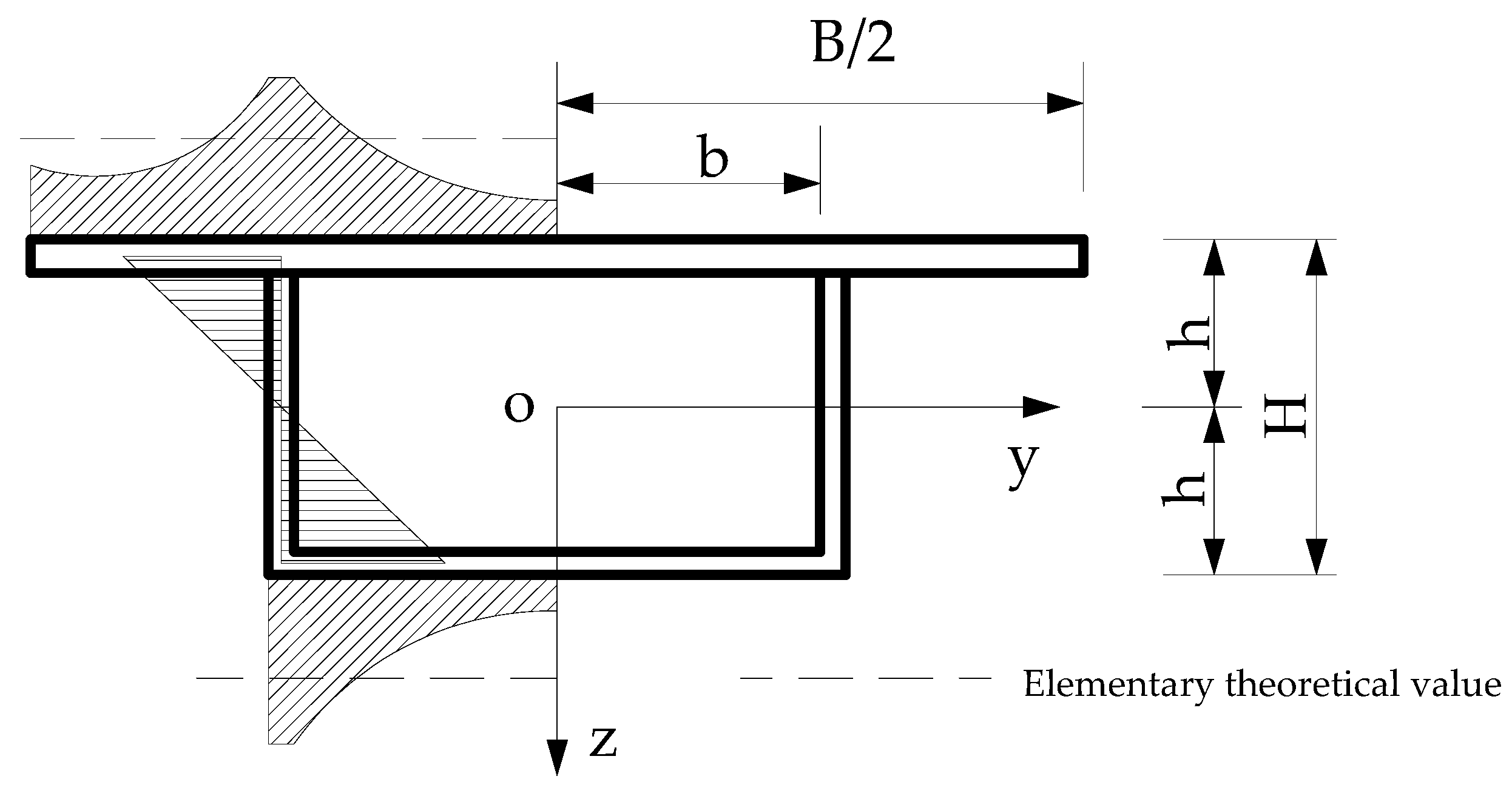

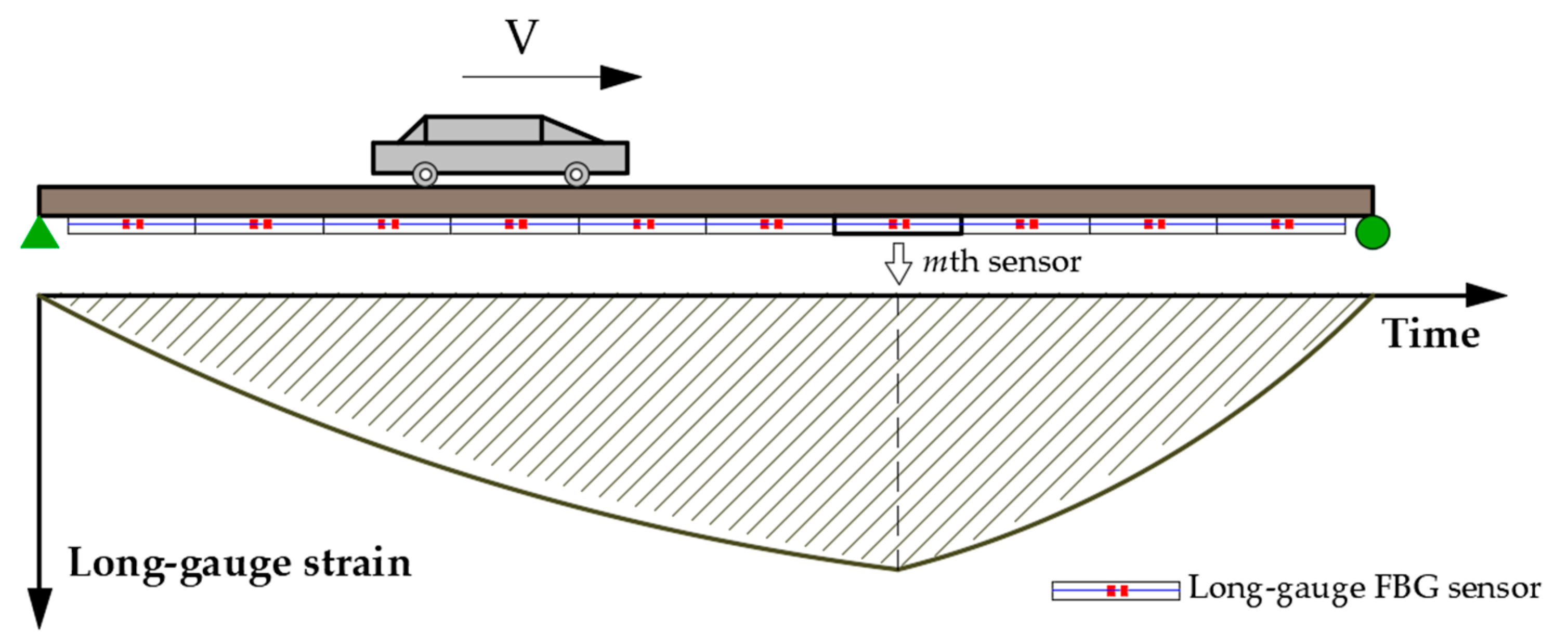
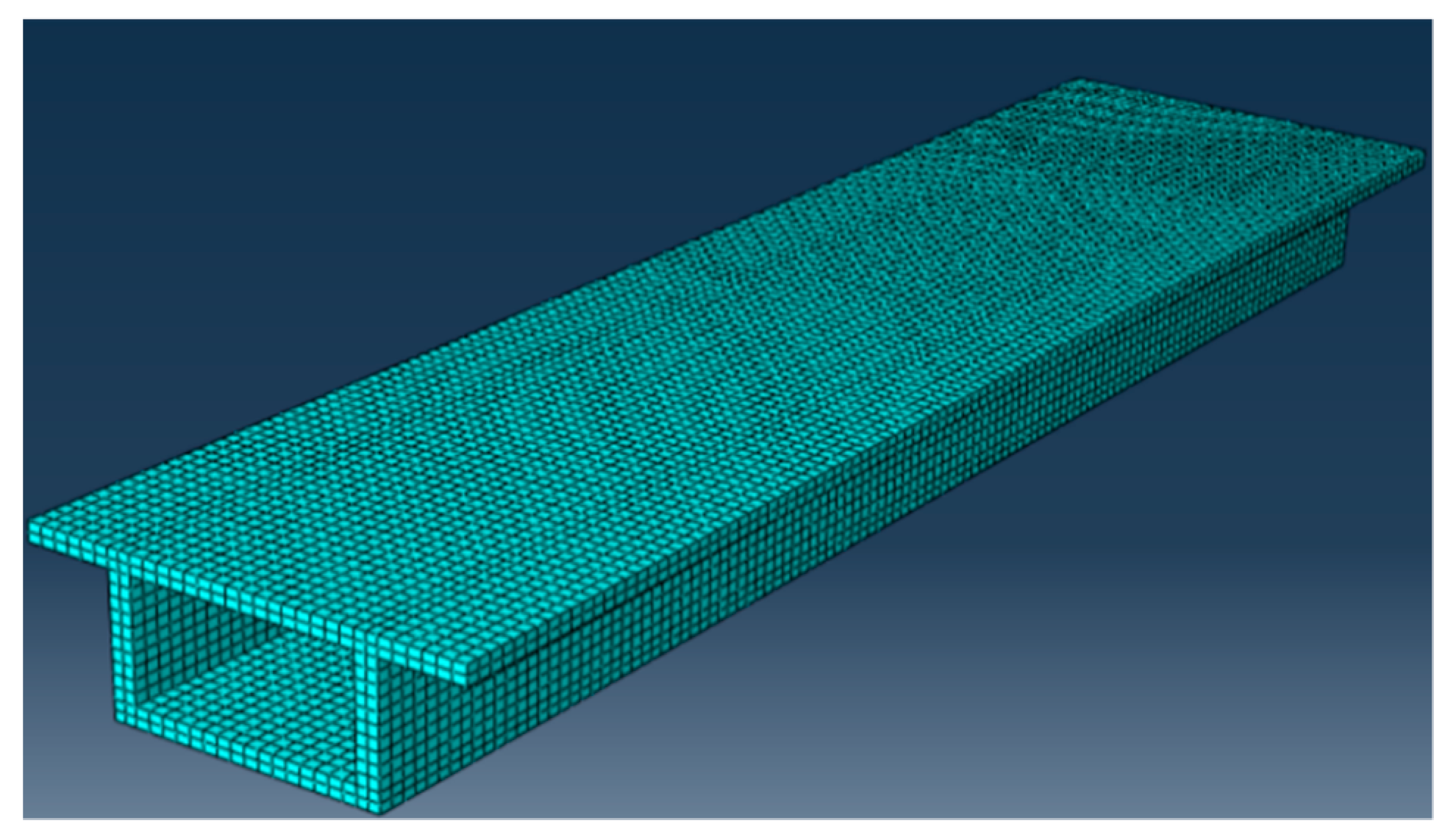

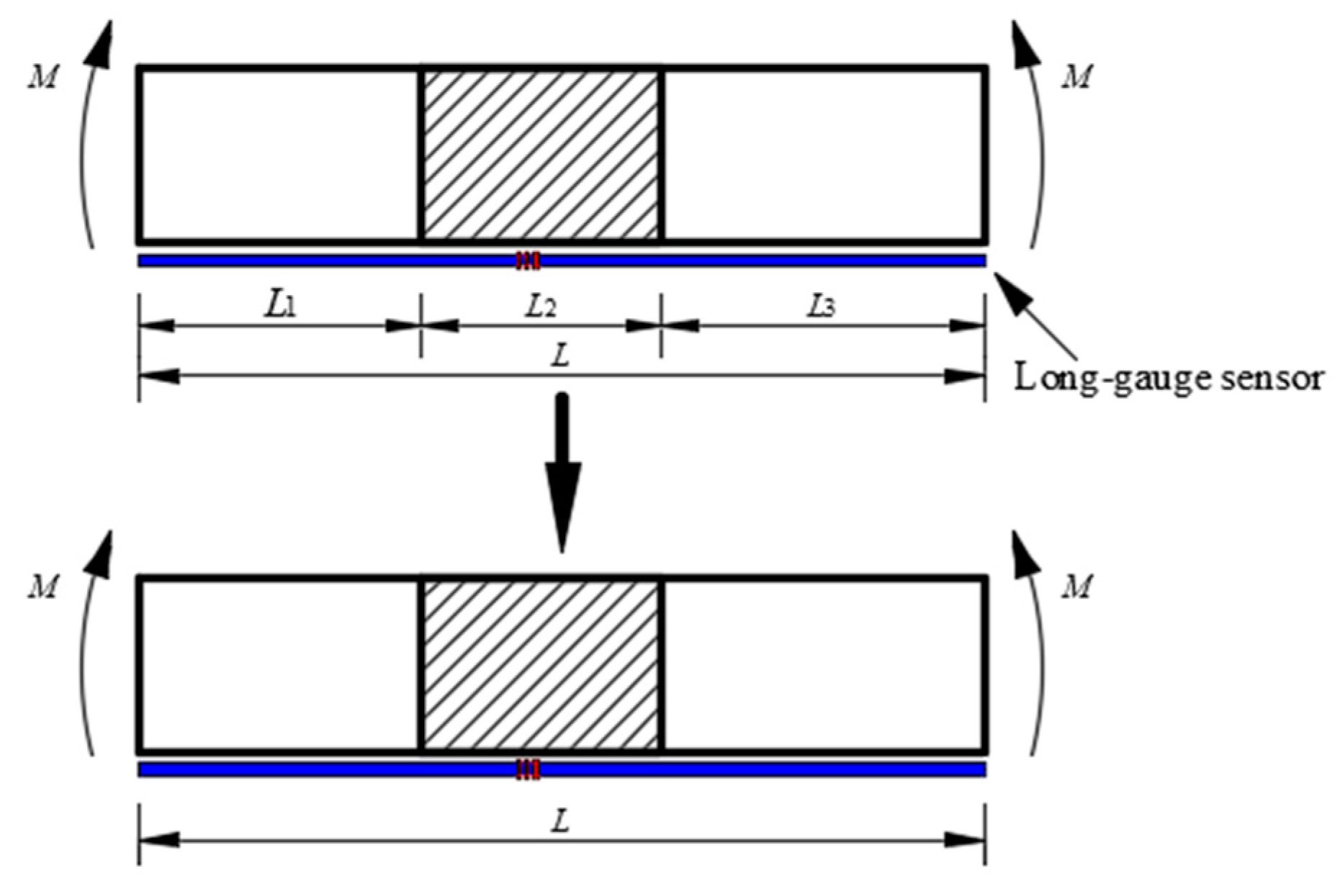
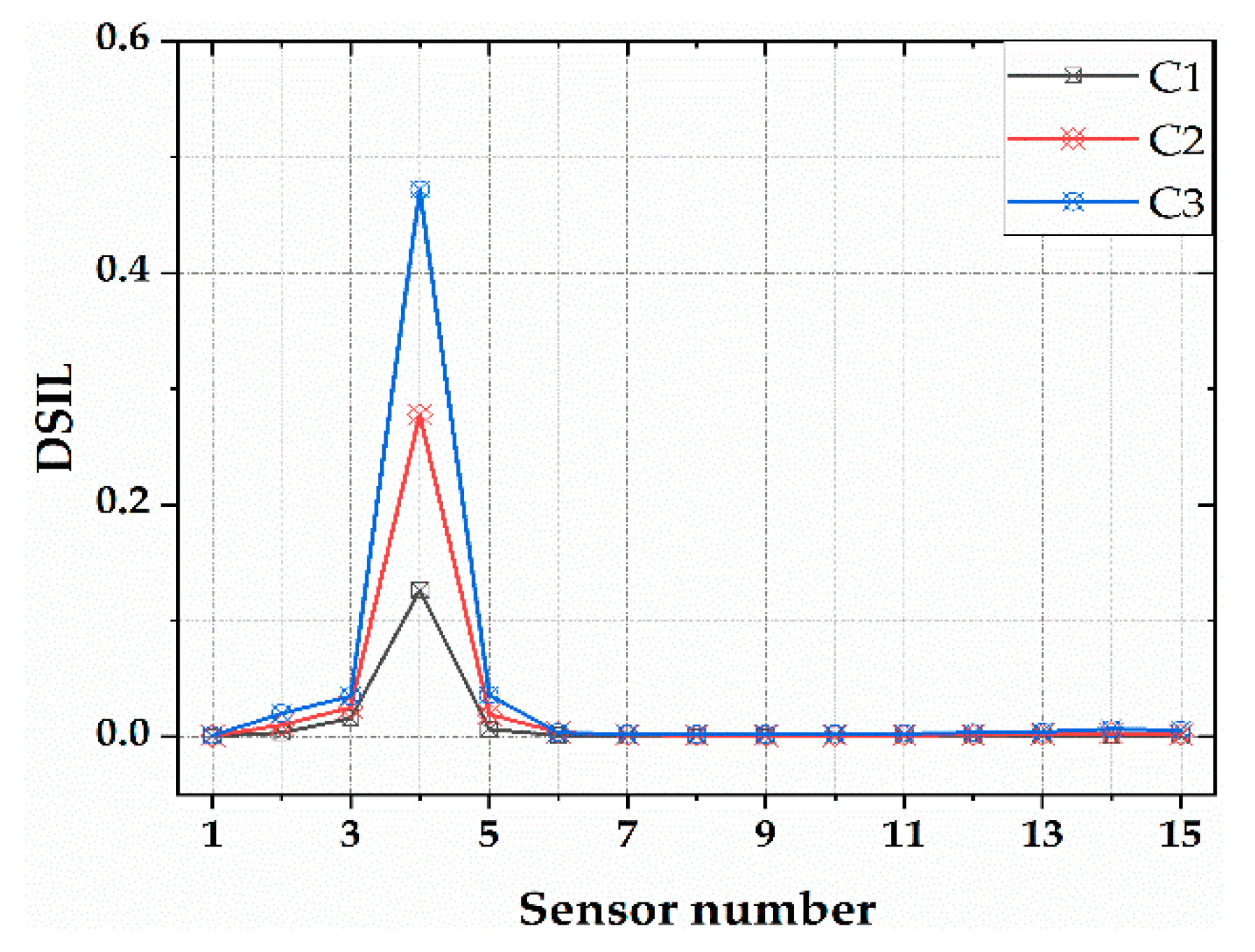
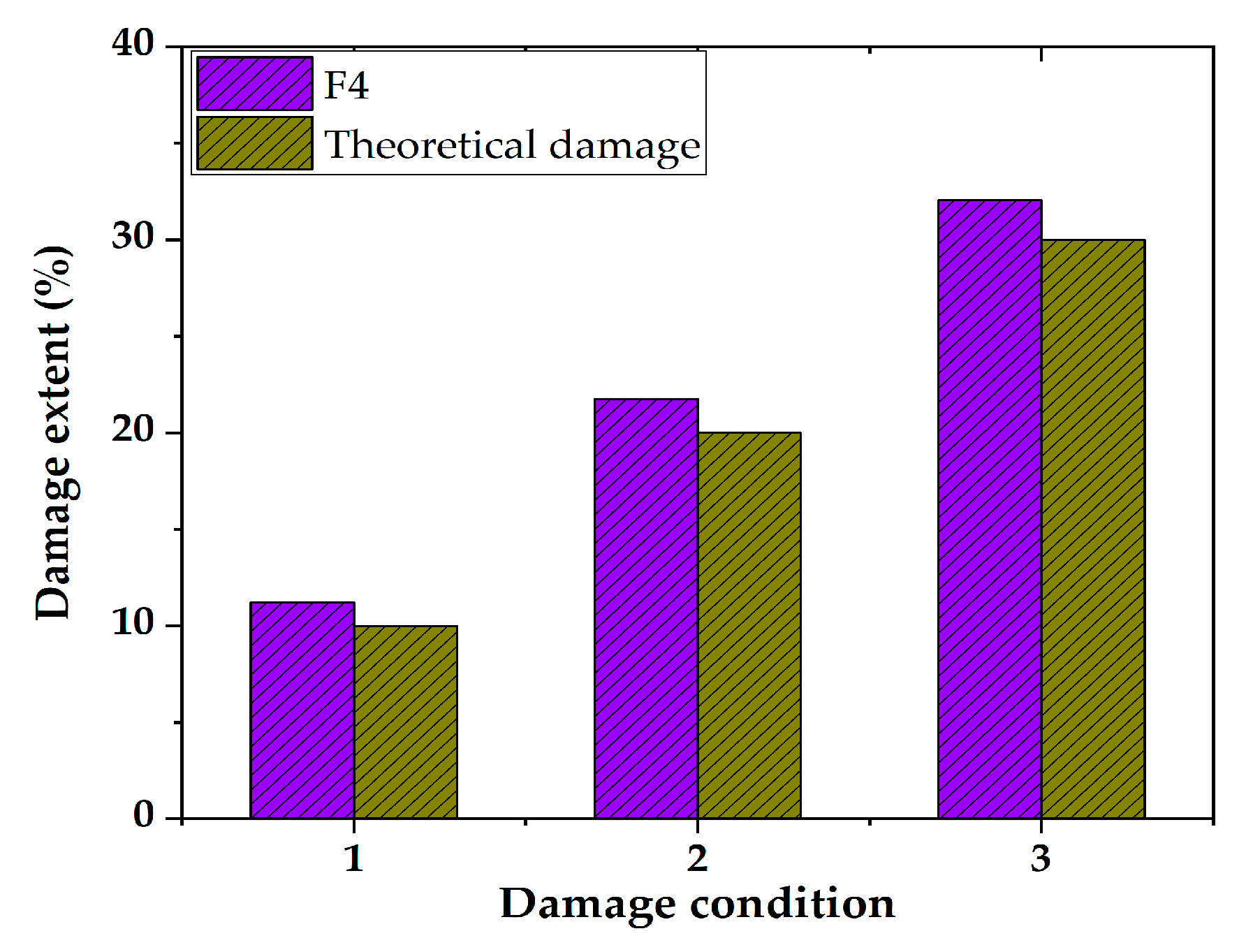
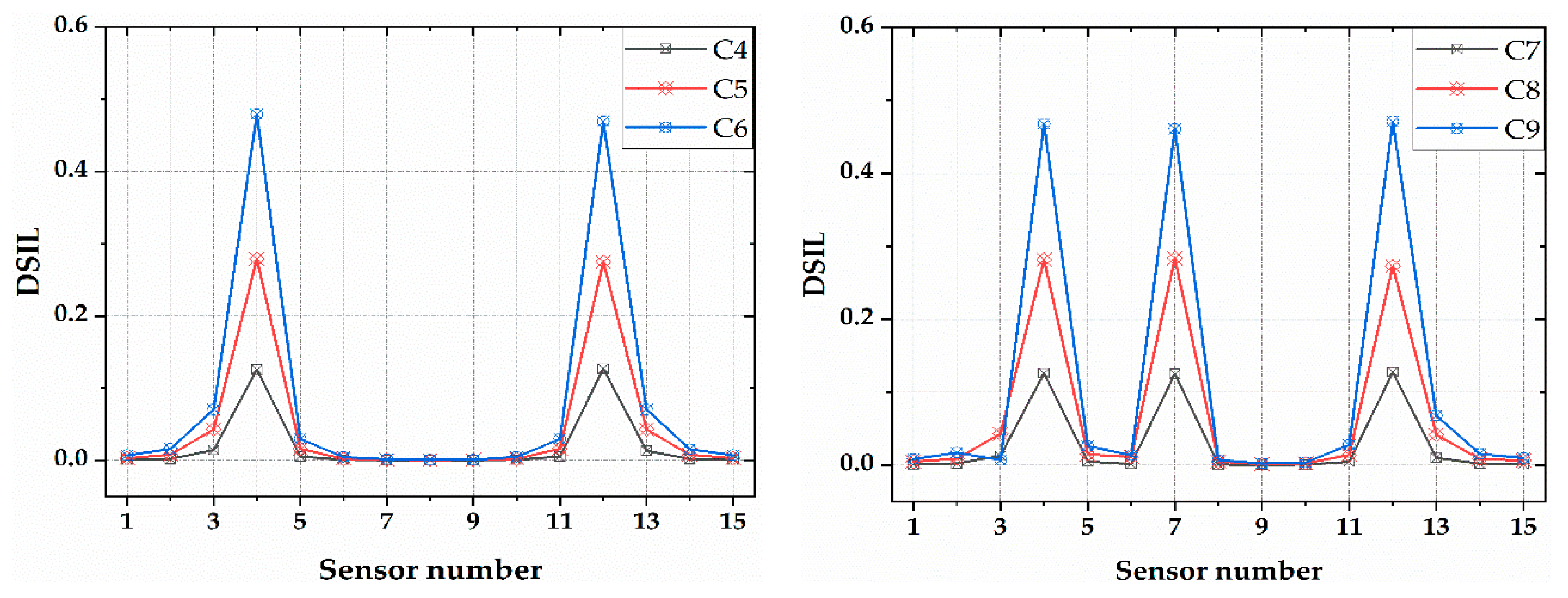
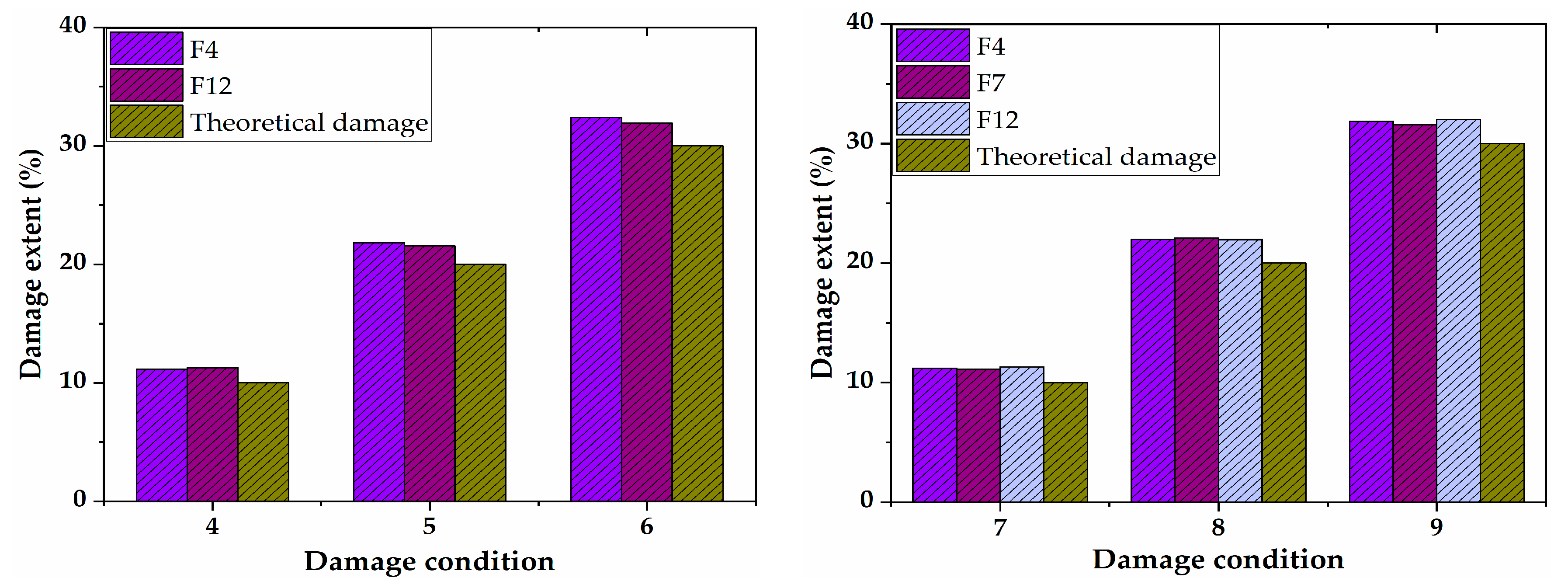

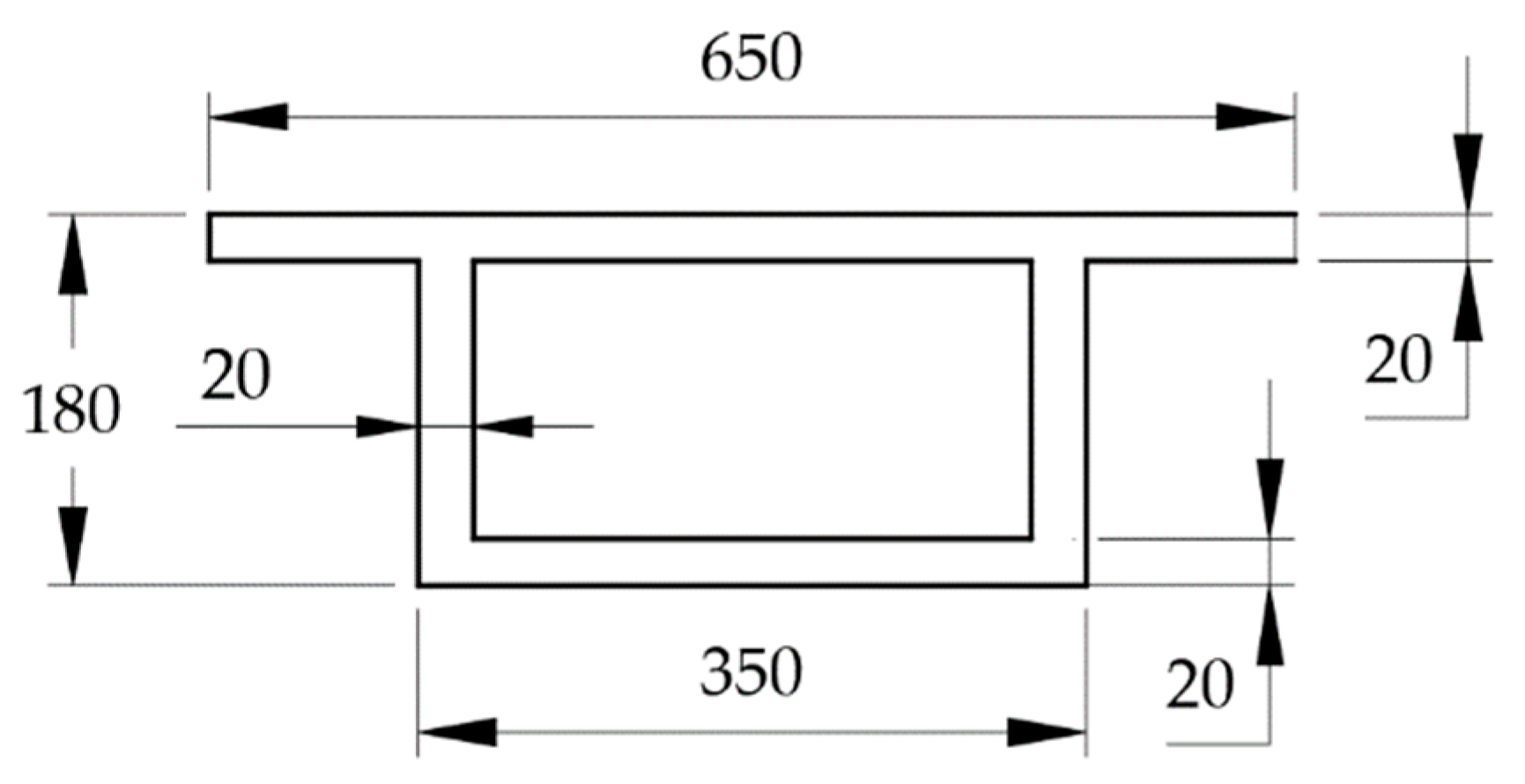

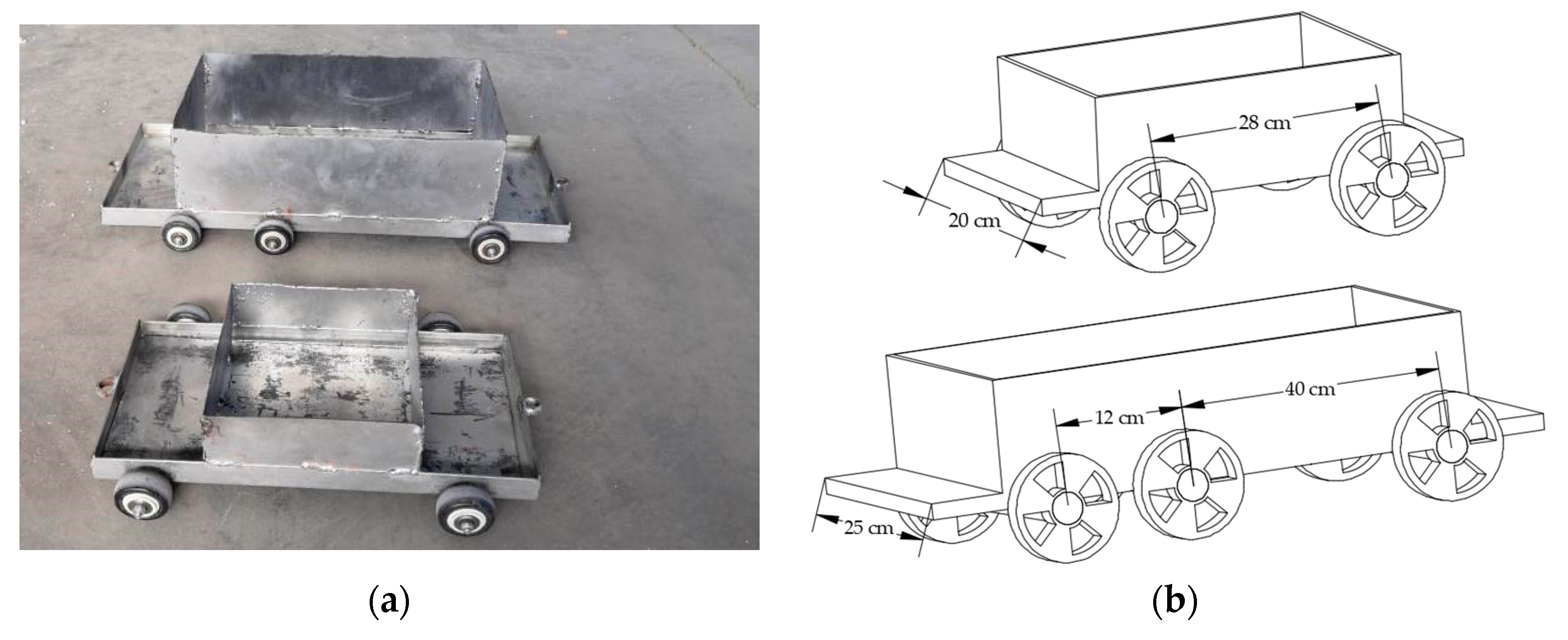

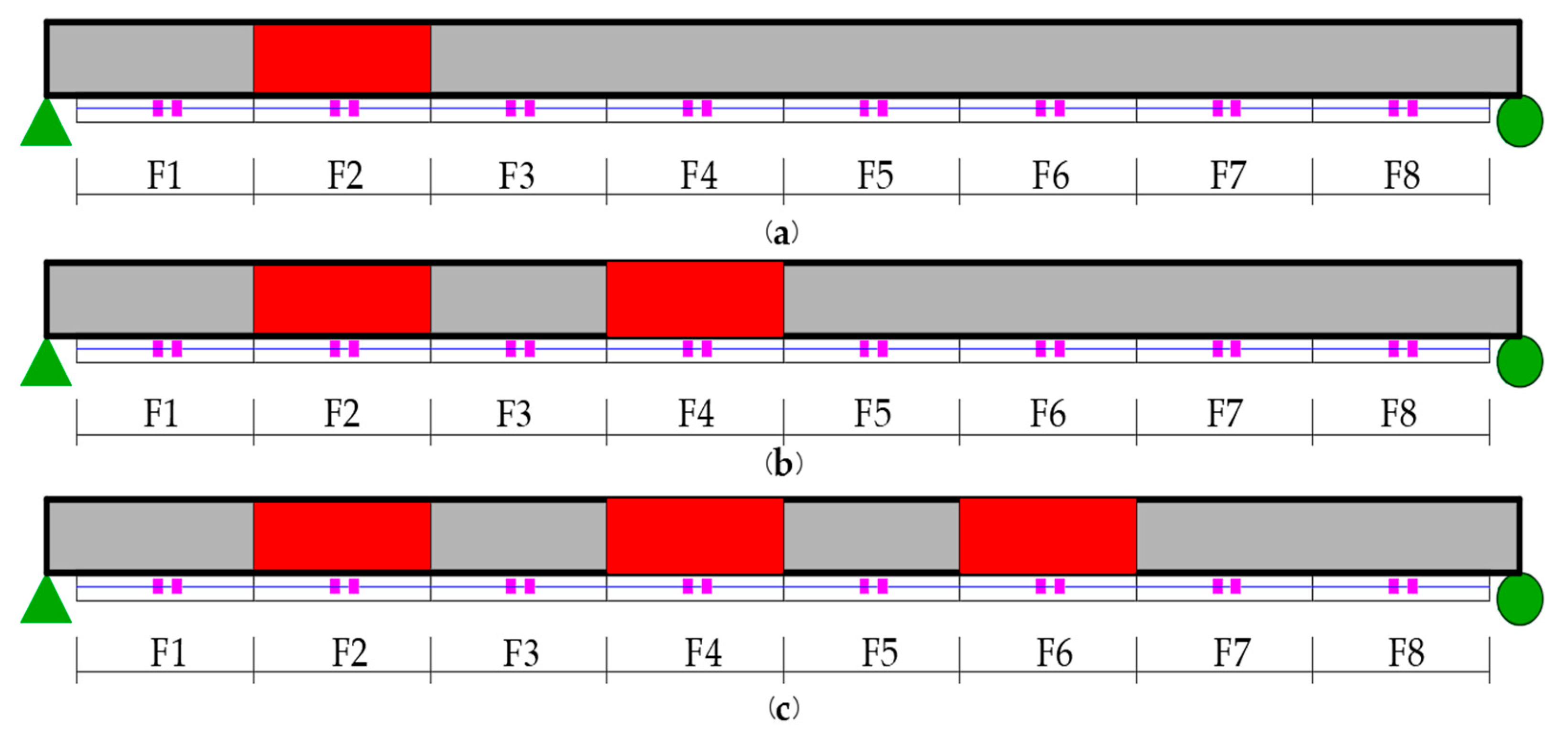
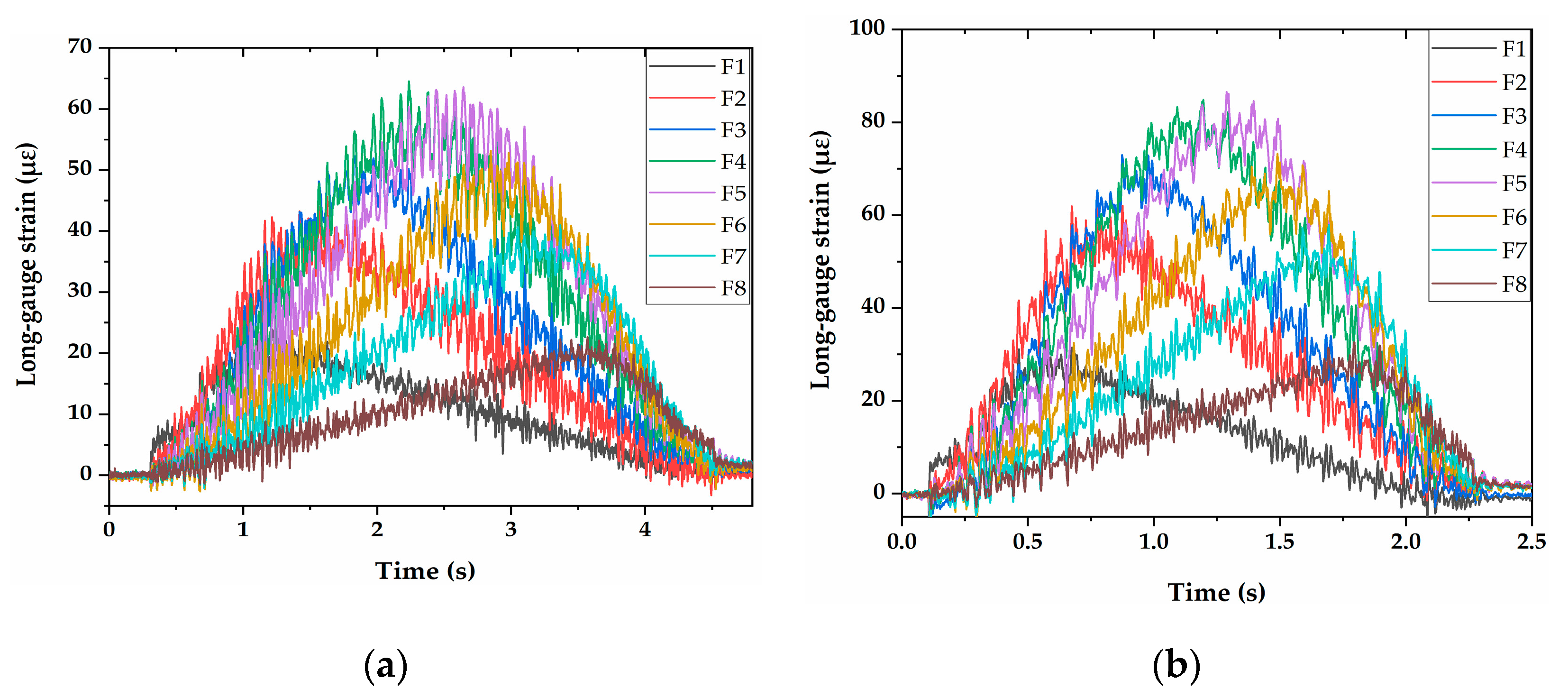


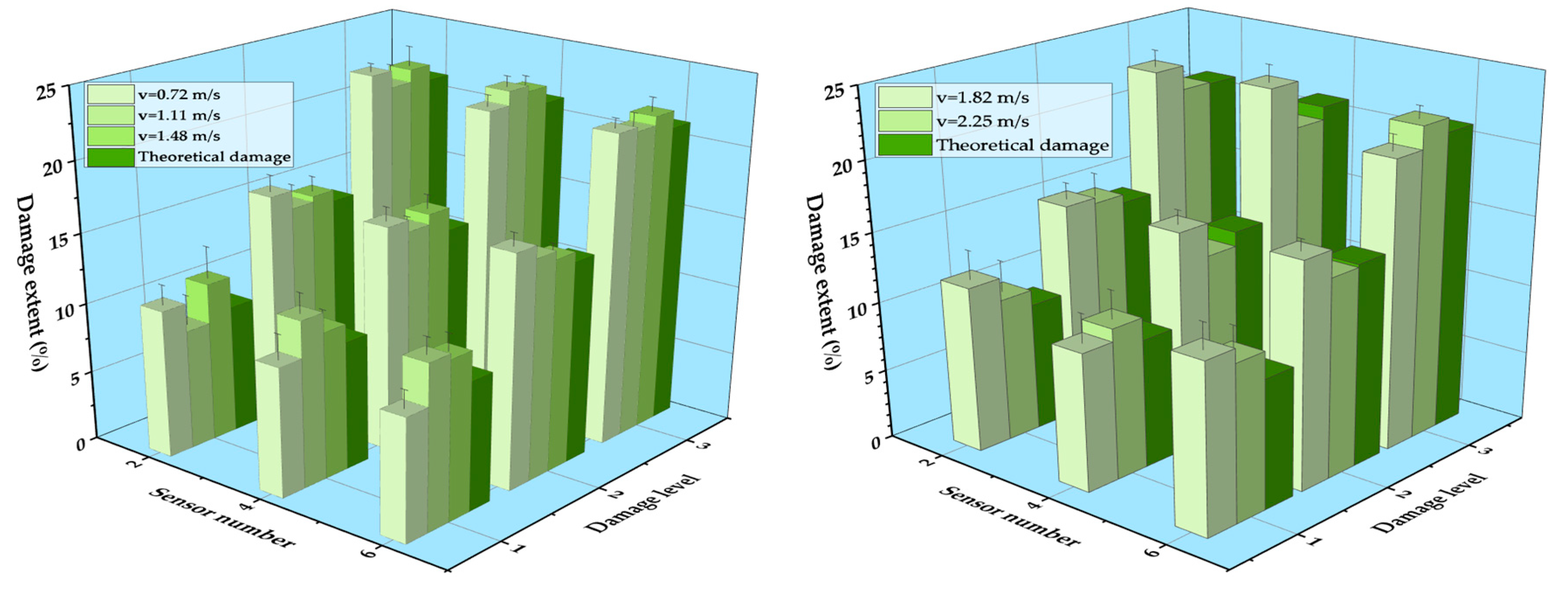




| Condition | Damage Location | Damage Extent | Damage Location | Damage Extent | Damage Location | Damage Extent |
|---|---|---|---|---|---|---|
| C0 | F4 | F7 | F12 | |||
| C1 | F4 | 10% | F7 | F12 | ||
| C2 | F4 | 20% | F7 | F12 | ||
| C3 | F4 | 30% | F7 | F12 | ||
| C4 | F4 | 10% | F7 | F12 | 10% | |
| C5 | F4 | 20% | F7 | F12 | 20% | |
| C6 | F4 | 30% | F7 | F12 | 30% | |
| C7 | F4 | 10% | F7 | 10% | F12 | 10% |
| C8 | F4 | 20% | F7 | 20% | F12 | 20% |
| C9 | F4 | 30% | F7 | 30% | F12 | 30% |
| Condition | Damage Location | Damage Extent | Damage Location | Damage Extent | Damage Location | Damage Extent |
|---|---|---|---|---|---|---|
| C0 | F2 | F4 | F6 | |||
| C1 | F2 | 9.19% | F4 | F6 | ||
| C2 | F2 | 14.43% | F4 | F6 | ||
| C3 | F2 | 21.25% | F4 | F6 | ||
| C4 | F2 | 21.25% | F4 | 9.19% | F6 | |
| C5 | F2 | 21.25% | F4 | 14.43% | F6 | |
| C6 | F2 | 21.25% | F4 | 21.25% | F6 | |
| C7 | F2 | 21.25% | F4 | 21.25% | F6 | 9.19% |
| C8 | F2 | 21.25% | F4 | 21.25% | F6 | 14.43% |
| C9 | F2 | 21.25% | F4 | 21.25% | F6 | 21.25% |
Publisher’s Note: MDPI stays neutral with regard to jurisdictional claims in published maps and institutional affiliations. |
© 2021 by the authors. Licensee MDPI, Basel, Switzerland. This article is an open access article distributed under the terms and conditions of the Creative Commons Attribution (CC BY) license (http://creativecommons.org/licenses/by/4.0/).
Share and Cite
Yang, J.; Hou, P.; Yang, C.; Yang, N.; Li, K. Damage Identification Method of Box Girder Bridges Based on Distributed Long-Gauge Strain Influence Line under Moving Load. Sensors 2021, 21, 915. https://doi.org/10.3390/s21030915
Yang J, Hou P, Yang C, Yang N, Li K. Damage Identification Method of Box Girder Bridges Based on Distributed Long-Gauge Strain Influence Line under Moving Load. Sensors. 2021; 21(3):915. https://doi.org/10.3390/s21030915
Chicago/Turabian StyleYang, Jing, Peng Hou, Caiqian Yang, Ning Yang, and Kefeng Li. 2021. "Damage Identification Method of Box Girder Bridges Based on Distributed Long-Gauge Strain Influence Line under Moving Load" Sensors 21, no. 3: 915. https://doi.org/10.3390/s21030915
APA StyleYang, J., Hou, P., Yang, C., Yang, N., & Li, K. (2021). Damage Identification Method of Box Girder Bridges Based on Distributed Long-Gauge Strain Influence Line under Moving Load. Sensors, 21(3), 915. https://doi.org/10.3390/s21030915






